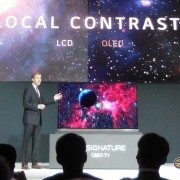OLED Rises to Become Purple Ocean of Existing Lighting Industry
OLED is receiving much attention as the next generation lighting as a greener lighting that can replace existing incandescent and fluorescent lights and reduce energy consumption, as well as lighting that can create new market. According to this trend, many organizations are analyzing OLED lighting industry in diverse directions and presenting the analysis.
At the 5th LED Industrial Forum which was held recently together with LED & OLED Expo 2015, Song Hyokyung, a senior researcher of WIPS, gave a presentation on the topic of OLED lighting industry’s patent trend and market status. She explained that as OLED lighting sector is a new market with a great growth potential, the technology development competition is fierce, and presented SWOT analysis results of Korean businesses.
For Korean OLED lighting industry’s strengths, Song gave examples which included world’s highest quality of OLED, AMOLED development and mass production technology, production ability, and diverse convergence technology solution. As for the opportunity factors, Song suggested application expansion through convergence with flexible technology, and increase in demand as the lighting market expands. On the other hand, Song revealed that the deficiency in original key technology on OLED material and components and the lack of mid to long term strategy regarding new technology development could be a weakness for Korean industry. She also gave China’s pursuit, possession of intellectual property rights by leading companies, and appearance of new light sources such as QLED (quantum dot emitting diode) as factors that could pose threat. However, OLED lighting induces warm atmosphere as well as being environmentally friendly and a future convergence industry. With these factors, Song concluded that if these weaknesses and threat factors can be overcome, OLED lighting will be able to show higher CAGR than other lighting markets.
UBI Research analyzed OLED lighting industry via STEEP analysis method in OLED Lighting Annual Report, published in May, 2015. UBI Research analyzed that as income increases, interest in interior design light using specialized lighting, other than necessary lighting, increases. Also, in terms of technology, OLED lighting projects in Korea, the US, and Europe are actively being carried out and estimated that the technology development will gain speed through related technology integration.
Economically, UBI Research analyzed that the market entry barrier is not high as the OLED lighting industry is not monopolistic. In terms of environment, incandescent lighting’s carbon production and fluorescent light’s mercury are becoming big concerns. Based on these factors UBI Research forecast that demand for green lighting, such as OLED lighting, will increase. Policy wise, OLED lighting industry clusters were formed and are supported by Korean and Japanese governments. As OLED lighting related projects are also being vigorously carried out OLED lighting industry is expected to become a high growth industry.
Based on both analyses OLED lighting is anticipated to be an industry with much potential for growth. If speedy technology development occurs and demand for environmentally friendly lighting increases, it is expected that the OLED lighting share of total lighting market will rapidly increase. UBI Research estimated that total OLED lighting market will grow at CAGR of approx. 70% from 2016, and show US$ 10,000 million revenue in 2025.












